Apr 28, 2017 | Alumni, Systems Analysis, Young Scientists
University of Tokyo researcher Ali Kharrazi credits the 2012 IIASA Young Scientists Summer Program (YSSP) with strengthening his passion, and giving him the research skills, to make a positive impact on humanity and sustainable development. He continues to collaborate with the institute as a guest researcher.

Ali Kharrazi
What is your research focus?
I’m currently examining both theoretical and empirical dimensions related to resilience and the wider application of sustainability indices and metrics. Towards this end, I have lately completed a literature review of empirical approaches to the concept of resilience, examined the resilience of global trade growth, and examined the resilience of water services within a river basin network.
My future project includes the examination of the application of modularity for resilience and its impact on other system characteristics of resilience, such as redundancy, diversity, and efficiency. In addition, I am collecting more data on the water-energy-food nexus, to empirically examine the resilience of these critical coupled human-environmental systems to various shocks and disruptions. I am working with other researchers towards channeling the emergence of urban big data towards practical research in sustainability indices and metrics, especially those which are related to resilience. Finally, I am engaged in what may be called ‘action research’ towards better teaching and engaging the concept of resilience to students.
How do you define resilience for a layperson or a student?
At its simplest, resilience is the ability of a system to survive and adapt in the wake of a disturbance.
The concept of resilience has been dealt by various disciplines: psychology, engineering, ecology, and network sciences. The literature on resilience relevant to coupled social-environmental systems therefore is very scattered, not approached quantitatively, and difficult to rely upon towards evidence based policy making. There are few empirical approaches to the concept of resilience. This makes it difficult to measure, quantify, communicate, and apply the concept to sustainability challenges.
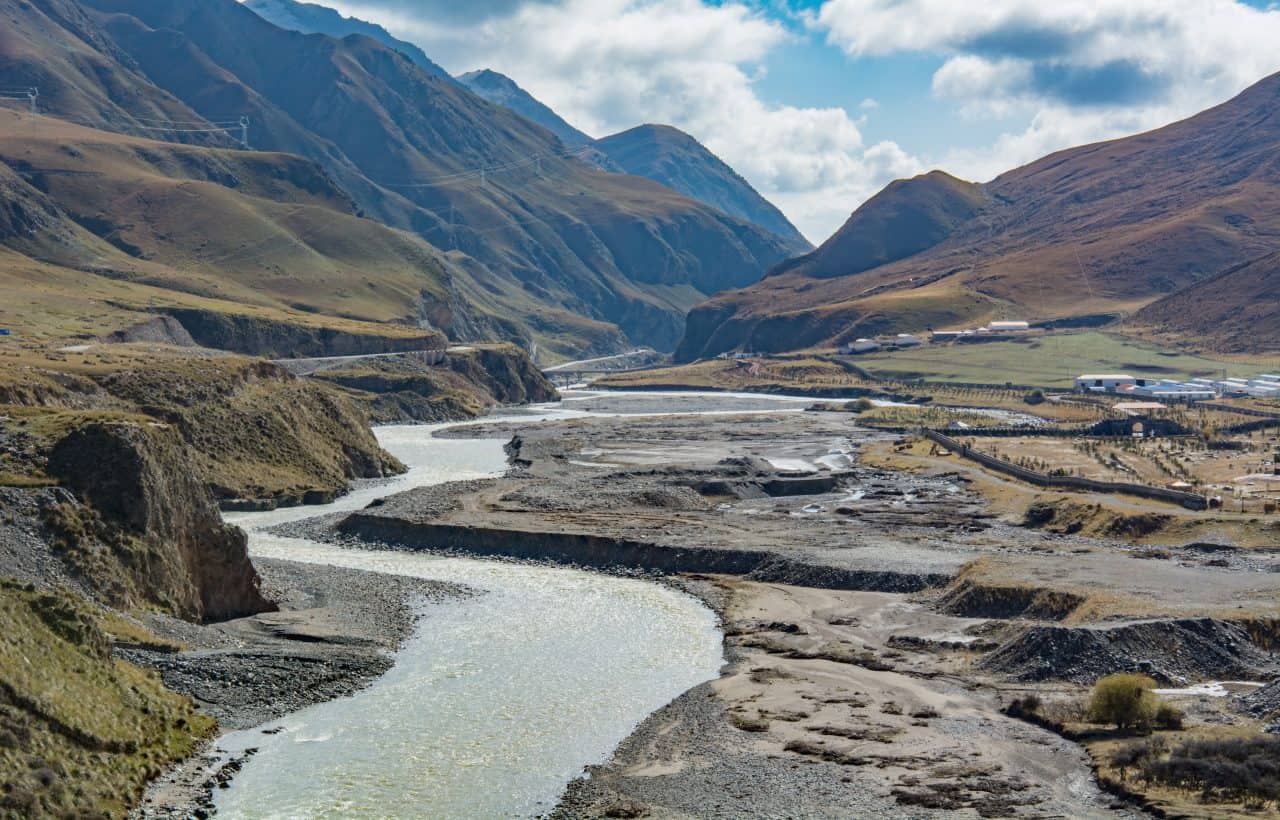
In a recent study, Kharrazi explored the resilience of the Heihe river basin in China ©smiling_z | Shutterstock
What is missing from current approaches of studying resilience?
There is a need for more empirical advancements on the concept of resilience. Furthermore, empirical approaches need to be tested with real data and improved for their ability to measure and apply in policymaking. If you look at the Sustainable Development Goals (SDGs) the concept of resilience is used numerous times, however the indicators used to reflect the concept need to be improved to better reflect the elements of the concept of resilience. This includes the ability to consider adaptation, the ability to integrate social and environmental dimensions, and the ability to evaluate systems-level trade-offs.
We need to apply the different empirical approaches to the concept of resilience towards real-world sustainability challenges. With the emergence of big data, especially urban big data, we can better apply and improve these models.
How did you personally become interested in this field of research?
I always wanted to make a positive impact for humanity and our common interest in sustainable development. When I first started my PhD, my PhD supervisor at Tokyo University, Dr. Masaru Yarime, told me to always set your sight on the ‘vast blue ocean’ and how as researchers we should dedicate our time to critically important yet less researched areas. Given the global discussions of SDGs and the Agenda 2020 at that time I became interested in the concept of resilience, its relationship to common sustainability challenges, and our inability to measure and quantify this importance concept. My research stay at IIASA and YSSP and especially my experience with the ASA group strengthened my passion to contribute to this area and therefore since my PhD I have continued to research in this area and apply it to various domains, such as energy, water, and trade.
How would you say IIASA has influenced your career?
Without IIASA and especially the YSSP in the Advanced Systems Analysis program, my academic career would have never taken off. I am truly indebted to the YSSP, where I learned how to engage in scientific research with others from diverse academic and cultural backgrounds and most importantly had the chance to publish high quality research papers. IIASA also gave me the chance to get experience in applying for international competitive funding schemes and truly believe in the importance of science diplomacy and influence of science on global governance of common human-environmental problems in our modern world.
Follow Ali Kharrazi on Twitter
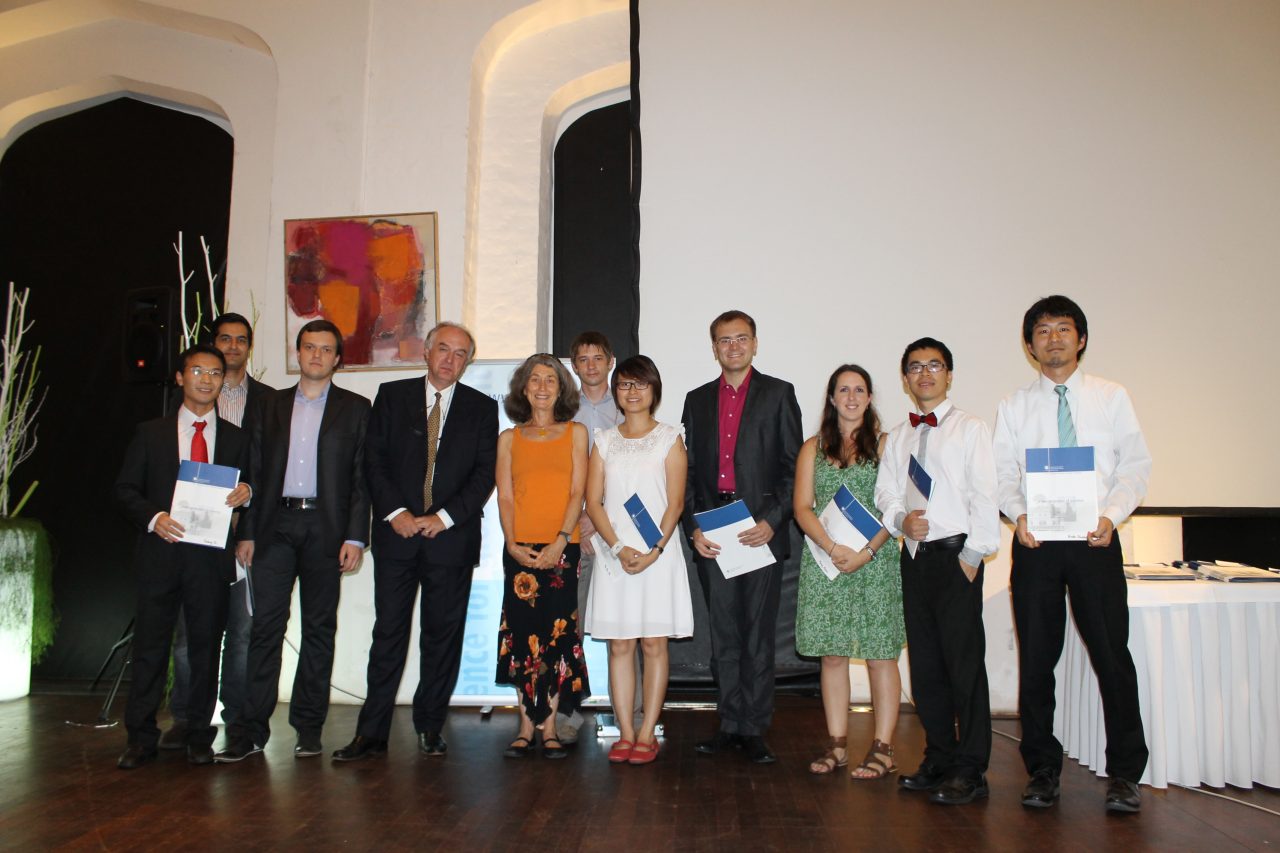
Ali Kharrazi, second from left, received his certificate with other participants of the 2012 YSSP
References
Kharrazi A, Akiyama T, Yu Y, & Li J (2016). Evaluating the evolution of the Heihe River basin using the ecological network analysis: Efficiency, resilience, and implications for water resource management policy. Science of the Total Environment 572: 688-696. http://pure.iiasa.ac.at/13594/
Kharrazi A, Fath B, & Katzmair H (2016). Advancing Empirical Approaches to the Concept of Resilience: A Critical Examination of Panarchy, Ecological Information, and Statistical Evidence. Sustainability 8 (9): e935. http://pure.iiasa.ac.at/13791/
Kharrazi A, Rovenskaya E, & Fath BD (2017). Network structure impacts global commodity trade growth and resilience. PLoS ONE 12 (2): e0171184. http://pure.iiasa.ac.at/14385/
This article gives the views of the author, and not the position of the Nexus blog, nor of the International Institute for Applied Systems Analysis.
Apr 24, 2017 | Sustainable Development
By Owen Gaffney, Stockholm Resilience Center (excerpted from a post on Rethink.earth)
What will the world be like in 2050?
Of course, it is difficult to make predictions, especially about the future, as the Danish proverb goes.
Part of the difficulty is that we – individuals and the institutions that allow us to act collectively and in the long term – routinely assume the future looks very much like the past. Just as routinely, though, this assumption is flipped on its head. Think of the global financial crisis, the Arab Spring, Brexit, or the recent US election.
But what if we already know what we want the world to look like in 2050. How do we get there?
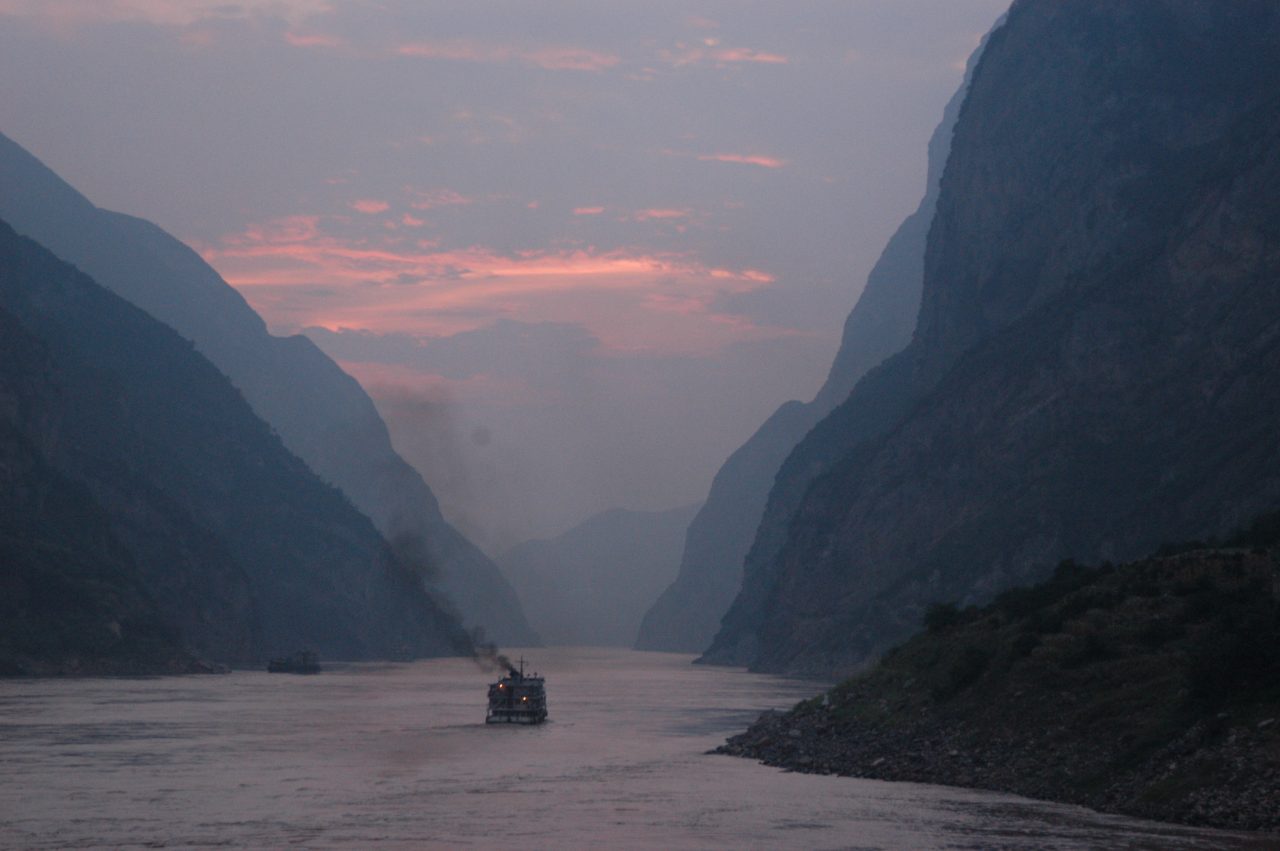
Dusk on Chang Jiang (Yangtze) Credit: Andrew Hitchcock | Flickr, CC BY 2.0,
I was reminded of the Danish proverb as I arrived at the International Institute for Applied Systems Analysis (IIASA) outside Vienna earlier this month for a three-day meeting of The World in 2050 (TWI2050) initiative. This was the third such scientific meeting hosted here at the home of some of the leading economic, demographic and energy modellers.
TWI2050 is arguably the most ambitious research being undertaken in the world today. At its heart is an ambition to map out the pathways for a sustainable planet. As with the previous meetings, it attracted about 130 complex-systems thinkers and computer-modelling experts.
Unlike other international modelling initiatives, TWI2050 was not created to explore a range of possible utopian to dystopian scenarios focusing on energy prices or climate change. The baseline assumption is a single scenario: successful completion of the Sustainable Development Goals (SDGs), agreed by all nations in 2015, and arriving in 2050 with a global economy operating within planetary boundaries – the limits of natural systems that keep Earth in a relatively stable state, relating to climate, biodiversity, deforestation, and fertilizer use, among others.
#winwin
The 17 SDGs and their 169 targets are extremely ambitious. Buried in the detail are many trade-offs but also potential win-wins. Meeting the climate goal means reducing greenhouse-gas emissions to zero, and this could affect the energy, biodiversity, or consumption goals either positively or negatively. The goals and their inherent trade-offs are already catalyzing research and the results show how challenging this will be.
This month, scientists publishing in the journal Nature explored Australia’s land-use trade-offs to reach the goals. The team, who were not at the TWI2050 meeting, used a massive computer simulation called Land Use and Trade Offs (LUTO) to see how factors such as climate policies or crop prices could shape Australia’s landscape by 2050. Exploring 648 scenarios, researchers Brett Bryan and Lei Gao found just 1% of scenarios achieved five goals simultaneously. However, some goals seemed to go better together than others. Achieving targets related to food, water, and biofuel production was possible in 6.5% of scenarios, for example. The authors, whose work contributes to Future Earth’s Global Land Programme, conclude that national policymakers need more of this type of analysis to elucidate trade-offs and avoid conflicting policies. Moreover, they argued for more scientific coordination internationally for a global perspective on implementing the SDGs.
Other research groups have also begun exploring the world in 2050. Recently Karl Heinz Erb from the Institute of Social Ecology, Vienna, who attended the TWI2050 workshop, and colleagues explored 500 scenarios to assess options for feeding 9 billion people in 2050 without further deforestation .
Their work, which also supports the Global Land Programme, concluded that it was possible, but would likely mean low meat, vegetarian, or vegan diets globally. Meanwhile, Marco Springmann from the Oxford Martin Programme on the Future of Food, also attending, and colleagues showed that by 2050 a global vegetarian diet would reduce diet-related global mortality by 6-10% and food-related greenhouse gas emissions by 29-70% – contributing to several goals. This type of research is essential to understand potential win-wins but these examples do not provide the pathways to arrive at these scenarios.
So, are computer models powerful enough to capture essential elements of incremental and disruptive change across complex issues relating to poverty, equality, education, technology, policy, energy, food, water, and climate? Read more on the Rethink.earth website
This article is excerpted from an article on the Rethink.earth website. It gives the views of the author, and not the position of the Nexus blog, nor of the International Institute for Applied Systems Analysis.
*The Stockholm Resilience Centre is one of the founding partners of The World in 2050 alongside the Sustainable Development Solutions Network and IIASA. Contributing organisations include the European Commission, Future Earth, Netherlands Environmental Assessment Agency, Potsdam Institute for Climate Impact Research, Future Earth. Check out the website for details.
References
Aug 29, 2016 | Sustainable Development
Pascal Lamy was the director general of the World Trade Organization from 2005 to 2013, and currently serves as a president emeritus of the Notre Europe – Jacques Delors Institute. On 28 and 29 August he is taking part in a meeting of the Alpbach-Laxenburg Group, focused on new models for sustainable business development.
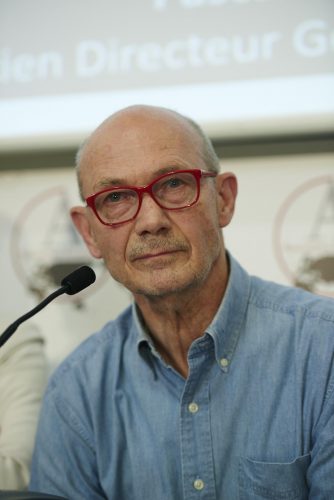
Pascal Lamy ©The Jacques Delors Institute
As the former director general of the WTO, you have extensive experience in global trade and economic development. How does this background inform your perspective on the issues of the sustainable development?
To put it very simply, there is a very well-understood interaction between trade and growth, starting in the 18th century until now. The understanding of the relationship between global trade and sustainable development, i.e. including the environment dimension, is much more recent, understandably because environmental issues only came into the picture much more recently than the 18th century.
The reality is today that the communities working on trade and environmental issues are rather poorly connected. You belong either to one or to the other. There are not that many people who have feet on both sides, which does not help because the issue is complex.
In theory it’s very simple. Take climate change for instance: If you put the carbon price at the proper level, i.e. the one that takes into account the externalities of climate change and CO2 emissions, all you have to do is price CO2 properly, and problem is solved: markets will reallocate production factors accordingly. That’s what theory tells us. The little problem is actually agreeing on a set price for the entire planet. And this triggers a lot of suboptimal propositions, solutions.
I think that the overall stance now is that that trade is not an end. Trade is a means to improve growth in climate, welfare, sustainability, including environment sustainability. This was in fact part of the WTO charter from 1994. When I was DG of the WTO we did quite a lot of work in collaboration with environmental international organizations such as UNEP for instance. We looked into the big question on this topic: Is the expansion of trade good or bad for the environment? There are arguments on both sides, and it is a vast set of issues. But overall I think there are ways and means to reconcile, to synergize the benefits of trade opening for a more environmentally sustainable world.
What do you see as the biggest challenge in achieving the Sustainable Development Goals?
It’s a very long and vast set of issues. So it’s not a single thing—what you have to address issues on inequality, on education, on oceans, on poverty—it’s a lot of different things.
But overall, I think the biggest challenge—and this is why a number of us are working on that—is to properly organize the accountability of these SDGs. That means providing proper metrics, proper review, proper debate, and proper public accountability. Now that the goals have been agreed by the UN, the issue is whether or not they can be achieved, and whether we can properly organize public pressure on sovereign nation states, through civil society, involvement of businesses. So in my view the main issue is building and agreeing on a proper follow up transparency system.
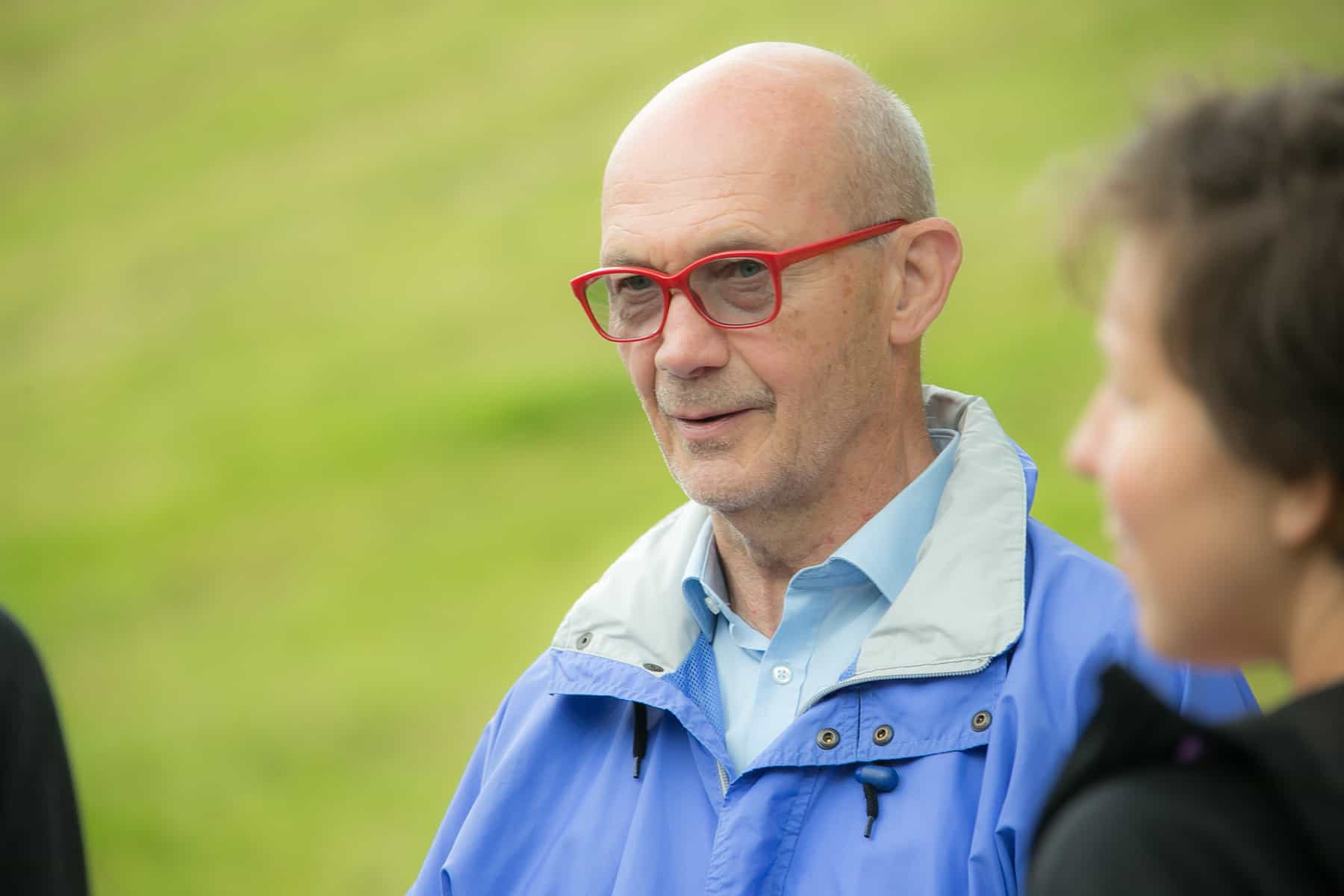
Pascal Lamy talks with other members of the Alpbach-Laxenburg Group at a retreat on 29 August. ©Matthias Silveri | IIASA
How do you think that the private sector could help in achieving the SDGs?
In doing what private businesses have been doing increasingly, which is integrating this sustainable development focus into their global strategies. Most big businesses now have a set of principles, a set of values that include sustainability.
What’s happening for instance around the push towards green finance, notably since the COP21 in Paris, is a good example of how some businesses can be on the front line of a larger coalition. We need coalitions like this to bind public authorities at the national, regional, and city levels, to civil society organizations focused on sustainability, climate, environment, biodiversity, and development, and businesses, whether big or small.
So from your perspective it sounds like business is already on the right track. What further changes would be needed in the private sector in order to fully embrace the SDG agenda?
It will happen if and when businesses realize that it matters to their consumers, to their staff, and to their shareholders, or their finance providers more generally. This is the frame within which they have to optimize what they do—clients, consumers, their people, and where they get their financial resources from. And if these various sides of the triangle push in that direction, inevitably businesses will push in this direction. They’ll have to.
The Alpbach-Laxenburg Group brings together leaders from business, and young entrepreneurs, along with government leaders and science experts. What do you think can be gained from a meeting of this type?
What’s unusual is that it links you with people whom you may not meet every day, so it’s an occasion of diversity connecting on a topic. Plus, there is something which tends to come out of this sort of environment, which is innovation. People exchanging ideas, not just theoretically, “What should we do?” “Where are we?” “Where are we going?” but, “This is what I suggest to do,” “This is what I tried and it worked,” and “This is what I tried and it didn’t work.” It’s more about experiences on the ground, which may then inspire more general conclusions.
Further reading
Pascal Lamy (2016). “Négociations climatiques et négociations commerciales : antinomie évidente ?“. Speech delivered at the 24th Meeting about Risk Management, AMRAE, at Lille, France, February 5th 2016. Download speech (PDF)
Pascal Lamy (2013). The Geneva Consensus: Making trade work for all. Cambridge University Press http://www.cambridge.org/ao/academic/subjects/law/international-trade-law/geneva-consensus-making-trade-work-all
Interview conducted and edited by Katherine Leitzell, IIASA science writer and press officer
Note: This article gives the views of the interviewee, and not the position of the Nexus blog, nor of the International Institute for Applied Systems Analysis.
Oct 14, 2015 | Systems Analysis
By Brian Fath, IIASA Advanced Systems Analysis Program and Towson University

Brian Fath. © Matthias Silveri | IIASA
The seminal book The Limits to Growth by Donella Meadows and colleagues was a first attempt to make a world model that integrated environment, economics, population, and industrial pollution. Without drastic changes to curb human population growth, consumption of non-renewable resources and industrial effluence, the model scenario projected a collapse of the world social-industrial system, because physically it is not possible to keep growing on a finite planet. This important message spurred many people in the environmental sciences, but was largely ignored, or worse ridiculed, by the dominant economic and political leaders. Perhaps their work was too pessimistic (although some could say realistic) and called for change for which society was not yet ready.
My co-authors and I feel their message was interpreted incorrectly. The restrictions imposed by The Limits to Growth do not entail stagnation and strife but rather give us an opportunity for new priorities, greater equity, and greater well-being. Living within the limits can offer agreeable, pleasant, even thriving and wonderful living conditions.
Therefore we have written a book, which shows that following nature provides guidance and pathways to Flourishing within Limits to Growth.
People today are confronted with a number of very serious problems: poverty, increased inequalities among countries and people, refugees, regional conflicts and civil wars, global climate change, accelerating exploitation of the global non-renewable and renewable resources, rapid land use change and urbanization, and increased emissions of harmful chemicals into the environment. History has shown us that we cannot solve these problems using traditional methods based on short-sighted economic growth.
Additionally, we know from natural laws that continuous growth in a finite environment is not possible. How can we ensure sustainable development for society on Earth? It would be possible by imitating the system that understands how to sustain long-term development: to learn from nature and follow nature’s way. Nature shifts from quantitative biomass growth when the resources become limiting to qualitative development by increasing resource use efficiency, in terms of both improved network connectivity and information on process regulation and feedbacks. The two main ecosystem functions, flow of energy and transfer of nutrients, are accomplished by renewable energy and complete recycling of the needed elements. Nature also originated and perfected the use the 3Rs: Reduce, Reuse, and Recycle.

“The restrictions imposed by The Limits to Growth do not entail stagnation and strife but rather give us an opportunity for new priorities, greater equity, and greater well-being” Photo: Innsbruck, Austria ©Nikolai Sorokin | Dollar Photo Club
Our book employs a global model to experiment with applying these properties of nature in society. Using global statistics, the model considers how the development will change if:
- A revenue-neutral, resource-based Pigovian tax is increased significantly and along with commensurate tax reduction to enhance recycling and application of renewable energy
- We increase investment in education, innovation, and research significantly to raise the level of understanding by the population and to develop new progressive ideas to address our global problems.
- We increase pollution abatement considerably to reduce its negative impacts on our health, nature, and production.
- We increase aid from the developed to the developing countries to 0.8% of GNP, which would enhance the cooperation among countries, reduce poverty and population growth and thereby also the number of refugees. In this context, it is important that the aid is given as support to education, health care, and family planning and not at all as military aid.
 The model calculations show that it is possible to obtain a win-win situation, where both industrialized and developing nations can achieve a better standard of living – the developing countries mostly quantitatively and the developed countries mostly qualitatively. The calculations are compared with scenarios based on “business as usual” practices. The business as usual scenario shows a major collapse around the year 2060, which is in accordance to the Limits to Growth results from 1972 and the follow-up-publications from the Club of Rome.
The model calculations show that it is possible to obtain a win-win situation, where both industrialized and developing nations can achieve a better standard of living – the developing countries mostly quantitatively and the developed countries mostly qualitatively. The calculations are compared with scenarios based on “business as usual” practices. The business as usual scenario shows a major collapse around the year 2060, which is in accordance to the Limits to Growth results from 1972 and the follow-up-publications from the Club of Rome.
Furthermore, the book demonstrates calculations of ecological footprints and sustainability by assessing our consumption and loss of work energy due to our use of resources and destruction of nature. These calculations lead to the following conclusions:
- Maintain natural areas and the ecosystem services they provide.
- Improve agricultural production by increasing efficiencies and technologies.
- Shift our thoughts and actions from quantitative growth to qualitative development, for instance by using the three R’s.
- Shift to renewable energy.
- Leave today’s policy focused entirely on short-sighted economic considerations and start to discuss how we can improve environmental management, increase the level of education and research, and achieve greater equality in society.
- Develop and promote alternative measures of welfare and well-being.
- Reduce, rather than reward, financial speculations, exorbitant profits, and stock market gambling.
More information: Listen to an interview with Brian Fath on WCBN Radio.
References
Jørgensen SE, Fath BD, Nielsen SN, Pulselli F, Fiscus D, Bastianoni S. 2015. Flourishing Within Limits to Growth: Following nature’s way. Earthscan Publisher.
Meadows, DH, Meadows, DL, Randers J., Behrens, W.H. III, (1972) Limits to Growth, New York: New American Library.
Note: This article gives the views of the author, and not the position of the Nexus blog, nor of the International Institute for Applied Systems Analysis.
Jun 3, 2015 | Energy & Climate
By Nebojsa Nakicenovic, IIASA Deputy Director General/Deputy Chief Executive Officer (originally published in UNA-UK’s report: Climate 2020: Facing the Future)
Zero net global greenhouse gas emissions must become a reality before the end of the century if humankind is to stave off the worst effects of climate change. How can this be achieved?
This is a big year for embarking on transformational change towards a sustainable future for planet Earth. Three major global events are taking place, on financing and investments in Addis Ababa, sustainable development in New York and climate mitigation in Paris.
Energy futures are a major challenge on the way forward. In September the UN General Assembly in New York will focus on the Sustainable Development Goals (SDGs), which emphasise an enabling environment and economy for human development.
According to Kandeh Yumkella, Special Representative of the UN Secretary-General for Sustainable Energy for All (SE4All), the proposed SDG 7 on energy (‘Ensure access to affordable, reliable, sustainable and modern energy for all’) is “the golden thread that links poverty eradication, equitable economic growth and a healthy environment”.
SE4All calls for universal access to energy services, doubling the rate of energy intensity improvement and doubling the share of renewable energy, all by 2030. These goals are based on the Global Energy Assessment (GEA), coordinated by the International Institute for Applied Systems Analysis (IIASA) and the result of five years’ work by 500 experts worldwide.

The Paris climate meeting in December aims for a major climate agreement. What will it take? Photo Credit: Moyan Brenn via Flickr
The world is also going to have to introduce a workable, implementable scheme to stave off the possibility of runaway climate change, one with the objective of keeping the average global surface temperature increase to within 2°C over the pre-industrial average. It’s doable, but requires a high level of ambition to achieve immediate and vigorous emissions reductions.
The UN Climate Change Conference in Paris in December 2015 is aiming for – and will hopefully get – a climate agreement based on the 2°C limit that will be legally binding on every nation. To come near to achieving this target will require addressing energy systems, which is central to greenhouse gas emissions mitigation – 80 per cent of global energy is derived from fossil fuels. Limiting emissions will involve a major transformation of energy systems toward full decarbonization.
Stabilization scenarios
But we need to move urgently. IIASA research has shown that to meet the 2°C target and avoid dangerous climate change, emissions will need to peak by 2020. By 2050, they will have to be reduced by 30 to 70 per cent compared to today’s levels, and then they will need to go down to zero well before the end of the century.
The reason is that the amount of carbon that can be emitted in the future is limited if we are to restrict climate change to any given level. For example, to meet the 2°C target, humanity has a total carbon budget of some thousand billion tons of carbon dioxide.
This budget needs to be allocated along possible emissions pathways, which explains the need for achieving a peak as soon as possible followed by a decline to zero emissions. Should the emissions peak be late or decline rate too slow, humanity is likely to exceed the cumulative carbon budget. If this occurs, negative emissions would be required: namely, carbon removal from the atmosphere, so that excess emissions are offset rendering stabilization at 2°C possible despite an emissions overshoot.
The question is how could this be done. In stabilization scenarios, the negative emissions are achieved, for instance, by combining combustion of sustainable sources of biomass with carbon capture and storage (CCS). Both technologies are difficult from the current perspective and would require further development and vigorous deployment to reduce the costs and improve their performance.
CCS will presumably be developed anyway to decarbonize fossil fuels in those parts of the world where a transformation toward renewable, and possibly also nuclear, energy is delayed.
So we can decarbonize fossil fuels or switch to a higher percentage of carbon-free energy sources, such as many forms of renewable energy, to reduce and eventually eliminate emissions. What else can we do? GEA findings show that emissions could be reduced by up to half by efficiency improvements in energy, especially in end-use. This means looking at reducing emissions from areas such as transport, buildings, heating and cooling, urbanisation and electric appliances. It means changing mindsets, getting people and policymakers engaged in the emissions-reduction process.
Not all emissions come from sources that are judged to be a sign of development. In many developing countries, cooking over smoky fires burning traditional biomass (or coal) causes small particle pollution that adversely affects the health of women and children. IIASA research is analyzing how to introduce clean modern energy for cooking to millions of people and to cut indoor and outdoor pollution from these sources.
Improving air quality in cities with ground-level ozone, or smog (which results from chemical reactions between polluting compounds in the presence of sunlight), has clear synergies for human health, reducing cardiac, pulmonary and other diseases. It can increase human capital, too. One line of IIASA research shows that implementing a stringent climate policy could reduce globally aggregated lives lost due to indoor and regional air pollution by up to four million.
Sectoral interdependencies with respect to emissions are increasing. For example, reducing carbon and particle emissions to keep climate change in check has enormous implications for the food and water supply. Staggering amounts of water are needed to grow food but are also needed for sustaining energy systems. The productivity of land areas depends on climate and soil conditions. California is entering its fourth year of severe drought, raising concerns for agriculture and wildlife. Unsustainable water use in the state is draining aquifers containing ancient water that will take centuries to replenish.
All water systems – not simply those in traditionally arid or developing areas – are vulnerable to the changing climate. Reducing water use immediately reduces demand for electricity, as well as the fuels required to generate electricity. Water is needed to grow crops for biofuels, but fuel transport costs can be reduced by co-locating biofuel cultivation close to the communities that use them – another IIASA research result. Water can also produce plenty of hydroelectricity. Renewable energy technologies can be utilised to provide heat and electricity needs for water desalination. Water and energy use have almost boundless synergies and have to be analysed from an integrated perspective, which is why at IIASA examining the energy-water nexus is such a priority.
Complex problems
Stringent emission-reduction policies can also help to bolster the energy security goals of individual countries and regions. Such policies promote energy efficiency, the diversification of the energy supply mix and the increased utilisation of domestically available renewable energy sources. The result would be energy systems that are more resilient and simultaneously have a higher degree of sovereignty, especially compared to those so reliant on imports of fossil energy commodities, such as North America, Europe, Japan and, increasingly, China.
The international community has also woken up to the significance of climate-relevant emissions from deforestation and land degradation. The UN’s REDD+ initiative (reducing emissions from deforestation and forest degradation) is one of the more promising areas of agreement in global climate negotiations. Felling a tree always releases carbon, stored over its lifetime in its roots, leaves and branches. Large-scale deforestation therefore is a major contributor to carbon emissions. Nitrogen emissions from agriculture, wastewater management and industrial processes are also produced by human activities and need to be mitigated.

Felling a tree always releases carbon, stored over its lifetime in its roots, leaves and branches. Large-scale deforestation therefore is a major contributor to carbon emissions. Photo Credit: Curt Carnemark / World Bank
These are complex problems and huge investments are needed to solve the energy challenges society faces today. The ostensibly single aim of reducing emissions will, in fact, require a multiple paradigm shift affecting every domain simultaneously. There are many golden threads, and they are very entangled.
To fund the transformation to sustainable energy services for all, including the three billion ‘left behind’ without access and living at or below the poverty line, the Third International Conference on Financing for Development in Addis Ababa in July will need to dig very deep into its collective pockets. To transform the global energy system, the volume of investment will have to almost double over the next three to five decades, from about $1.3 trillion to some $2.5 trillion.
The money is available. Insurance and pension funds control $50 trillion. Governments can help catalyse other kinds of private investment by providing research and development and early deployment, and by helping to de-risk investment. The cost savings of these climate policy synergies are potentially enormous: $100-600 billion annually by 2030 in reduced pollution control and energy security expenditures (0.1-0.7 % of GDP) could be achieved by combining climate mitigation with combating air pollution rather than pursuing the two goals independently.
For emission reductions to be successful, these practical and financial considerations will need to be supported by a new ethical awareness that will temper our relationship with each other and our planet. Sustainability in every aspect of human life means a shift to equity and inclusion.
With the fast-growing population and the need for universal development, the requirement to control emissions is extremely urgent. The golden thread described by Yumkella with respect to the energy sustainable development goal encompasses the notions of both opportunity and fragility, but it binds us all.
Read the full publication: Climate 2020: Facing the future (PDF).












You must be logged in to post a comment.